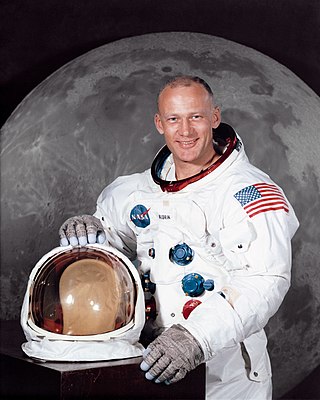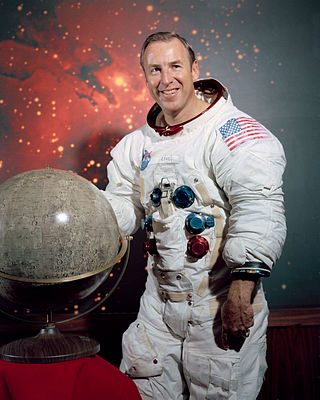
Apollo 11 was a spaceflight conducted by the United States from July 16 to July 24, 1969. It marked the first time in history that humans landed on the Moon. Commander Neil Armstrong and Lunar Module Pilot Buzz Aldrin landed the Apollo Lunar Module Eagle on July 20, 1969, at 20:17 UTC, and Armstrong became the first person to step onto the Moon's surface six hours and 39 minutes later, on July 21 at 02:56 UTC. Aldrin joined him 19 minutes later, and they spent about two and a quarter hours together exploring the site they had named Tranquility Base upon landing. Armstrong and Aldrin collected 47.5 pounds (21.5 kg) of lunar material to bring back to Earth as pilot Michael Collins flew the Command Module Columbia in lunar orbit, and were on the Moon's surface for 21 hours, 36 minutes, before lifting off to rejoin Columbia.

Neil Alden Armstrong was an American astronaut and aeronautical engineer who, in 1969, became the first person to walk on the Moon. He was also a naval aviator, test pilot, and university professor.

Buzz Aldrin is an American former astronaut, engineer and fighter pilot. He made three spacewalks as pilot of the 1966 Gemini 12 mission, and was the Lunar Module Eagle pilot on the 1969 Apollo 11 mission. He was the second person to walk on the Moon after mission commander Neil Armstrong. Following the death of Michael Collins in 2021, he is the last surviving Apollo 11 crew member.

Michael "Mike" Collins was an Italian-American astronaut who flew the Apollo 11 command module Columbia around the Moon in 1969 while his crewmates, Neil Armstrong and Buzz Aldrin, made the first crewed landing on the surface. He was also a test pilot and major general in the U.S. Air Force Reserve.

David McDowell Brown was a United States Navy captain and NASA astronaut. He died on his first spaceflight, when the Space Shuttle Columbia (STS-107) disintegrated during orbital reentry into the Earth's atmosphere. Brown became an astronaut in 1996 but had not served on a space mission prior to the Columbia disaster. He was posthumously awarded the Congressional Space Medal of Honor.

James Arthur Lovell Jr. is an American retired astronaut, naval aviator, test pilot and mechanical engineer. In 1968, as command module pilot of Apollo 8, he became, with Frank Borman and William Anders, one of the first three astronauts to fly to and orbit the Moon. He then commanded the Apollo 13 lunar mission in 1970 which, after a critical failure en route, looped around the Moon and returned safely to Earth.

Robert Brent "Bob" Thirsk, is a Canadian retired engineer and physician, and a former Canadian Space Agency astronaut. He holds the Canadian record for the most time spent in space. He became an officer of the Order of Canada (OC) in 2013 and was named to the Order of British Columbia (OBC) in 2012.

Dafydd Rhys "David" Williams is a Canadian physician, public speaker, author and retired CSA astronaut. Williams was a mission specialist on two Space Shuttle missions. His first spaceflight, STS-90 in 1998, was a 16-day mission aboard Space Shuttle Columbia dedicated to neuroscience research. His second flight, STS-118 in August 2007, was flown by Space Shuttle Endeavour to the International Space Station. During that mission he performed three spacewalks, becoming the third Canadian to perform a spacewalk and setting a Canadian record for total number of spacewalks. These spacewalks combined for a total duration of 17 hours and 47 minutes.

Charles Eldon Brady Jr. was an American physician, a captain in the United States Navy and a NASA astronaut. He spent 16 days in space on the Space Shuttle's STS-78 flight in 1996.

Project Gemini was the second United States human spaceflight program to fly. Conducted after the first American crewed space program, Project Mercury, while the Apollo program was still in early development, Gemini was conceived in 1961 and concluded in 1966. The Gemini spacecraft carried a two-astronaut crew. Ten Gemini crews and 16 individual astronauts flew low Earth orbit (LEO) missions during 1965 and 1966.

Apollo 11 was the first human spaceflight to land on the Moon. The 1969 mission's wide effect on popular culture has resulted in numerous portrayals of Apollo 11 and its crew, Neil Armstrong, Buzz Aldrin, and Michael Collins.
Astronauts Gone Wild: Investigation Into the Authenticity of the Moon Landings is a 2004 Pseudo-documentary produced and directed by Bart Sibrel, a Nashville-based videographer who claims that the six Apollo Moon landings in the 1960s and 1970s were elaborate hoaxes. Sibrel made this video as a follow-up to his 2001 video A Funny Thing Happened on the Way to the Moon, which accuses NASA of falsifying the Apollo 11 mission photography. The title of the presentation is a wordplay on the Girls Gone Wild video series.

Fly Me to the Moon is a 2008 animated science fiction comedy film about three flies who stowaway aboard Apollo 11 and travel to the Moon. It was directed by Ben Stassen and written by Domonic Paris. The film was released in digital 3-D in Belgium on 30 January 2008, and in the US and Canada on 15 August. The film was also released in IMAX 3-D in the US and Canada on 8 August. The film serves as a fictionalized retelling of the 1969 Apollo 11 mission by incorporating a story of three young flies that stow away on the rocket to fulfill their dream of going up to the moon, while their families take on a group of Soviet flies who try to sabotage the mission.

The USS Hornet Sea, Air & Space Museum is a museum ship, located on the southernmost pier of the former Naval Air Station Alameda in Alameda, California, US.
Robert Godwin is a British author who has written about rock music and spaceflight. Early in his career he was a rock music impresario who managed a venue in Burlington, Ontario, and founded Griffin Music.

The mobile quarantine facility (MQF) was a converted Airstream trailer used by NASA to quarantine astronauts returning from Apollo lunar missions for the first few days after splashdown. The MQF was on the aircraft carrier that picked up the capsule. Once the aircraft carrier reached port, the MQF was flown to Houston, and the crew served the remainder of the 21 days of quarantine in the Lunar Receiving Laboratory at the Manned Spacecraft Center. The purpose of the quarantine was to prevent the spread of any contagions from the Moon, though the existence of such contagions was considered unlikely. It functioned by maintaining a lower pressure inside and filtering any air vented.

John Hirasaki is an American mechanical engineer who worked for the United States' National Aeronautics and Space Administration (NASA) during the Apollo 11 mission, the first crewed mission to the Moon. In 1969 he – along with Buzz Aldrin, Neil Armstrong, Michael Collins, and William Carpentier – became one of the first five known humans to view lunar rocks inside Earth's atmosphere.

Apollo 11 was the first human spaceflight to land on the Moon. In the decades after its 1969 mission took place, widespread celebrations have been held to celebrate its anniversaries.

Lunar Module Eagle (LM-5) is the spacecraft that served as the crewed lunar lander of Apollo 11, which was the first mission to land humans on the Moon. It was named after the bald eagle, which was featured prominently on the mission insignia. It flew from Earth to lunar orbit on the command module Columbia, and then was flown to the Moon on July 20, 1969, by astronaut Neil Armstrong with navigational assistance from Buzz Aldrin. Eagle's landing created Tranquility Base, named by Armstrong and Aldrin and first announced upon the module's touchdown.

















